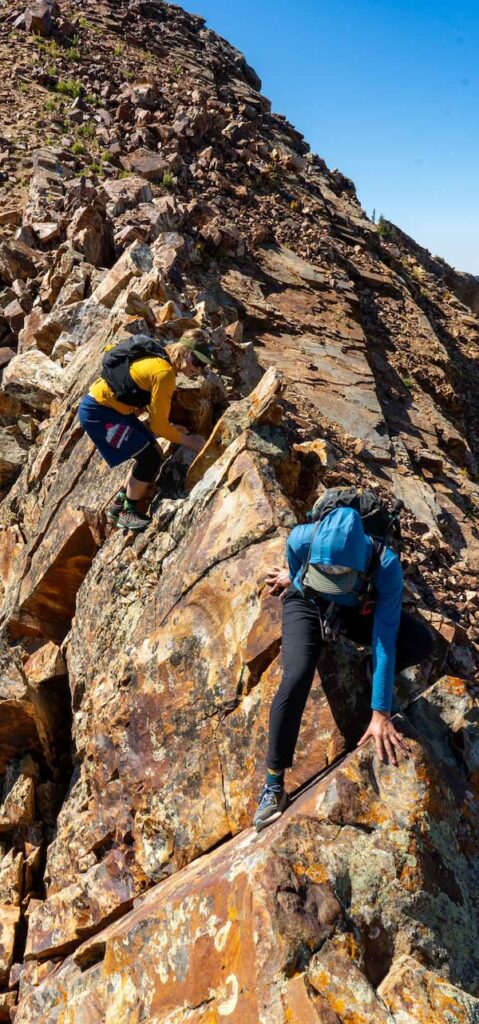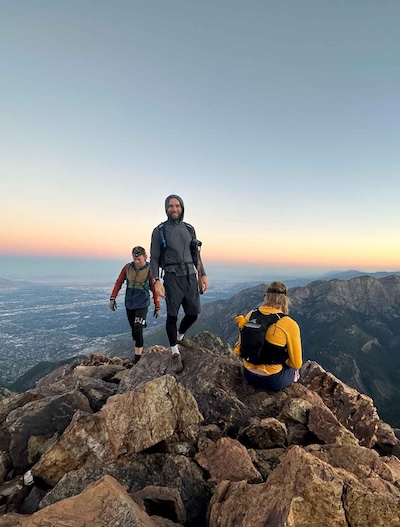The right clothing can make or break your hiking experience. In some cases, choosing the right clothes is a serious safety issue. If you don’t dress for the weather, you may find yourself dealing with heat exhaustion, hypothermia, or other weather-related hazards. But sometimes the weather isn’t the only thing that drives your decision to wear a specific hiking outfit. Today, we’re going to talk about hiking shorts, hiking pants, and what can help you choose which to wear.
Hiking Pants

In this photo, two friends are hiking on difficult terrain. One with shorts and leggings, and another in hiking pants. What suits one person, may be different from another, and that’s okay!
The best types of long pants for hiking are those that are durable, comfortable, and offer good protection. You should always look for hiking pants that are made from quick-drying, moisture-wicking, and breathable materials. Synthetic fabrics like nylon, polyester, or blends with spandex are commonly used because they’re durable and often water-resistant.
Durability is also important for hiking pants; hiking often involves rough terrain, so durable pants made from ripstop fabrics that can withstand abrasions and resist tears are beneficial. This is especially true if you’re bushwacking and are likely to come in contact with hazardous plants. The right pair of long pants can protect you from thorns, as well as common irritants like poison ivy, poison oak, and poison sumac.
Your hiking pants should also be comfortable and provide a good range of motion. Hiking often entails more movement than regular walking; you may need to scramble over boulders or debris fields, find your way through challenging terrain, or even cross a river or stream. Outdoor clothing makers often include features like crotch gussets and articulated knees that can offer better mobility than pants made without these considerations. For similar reasons, look for lightweight pants that pack easily and won’t weigh you down as you go.
Pockets are a major benefit to long hiking pants. The longer the pants, the more space there is for storage! Additionally, long pants with items in the pockets won’t flap around like shorts do– the length and weight of the fabric act as an anchor.
Another key benefit of long hiking pants is protection. As mentioned above, long pants can protect you from hazardous plants and rough terrain, but they can also offer a significant degree of sun protection. They can also help protect you from biting insects and are one of the best ways to prevent tick bites. If you’re hiking in tick country, you should always check yourself thoroughly, no matter what you’re wearing– but long pants are an additional layer of protection. You can also treat the fabric of your pants (or shorts) with tick repellent to keep the biting pests away. Tick-borne diseases are no joke, so make sure you keep yourself protected!
Hiking pants come in many different styles, including cargo pants and convertible pants. Convertible pants have lower legs that zip off and allow the pants to transform into shorts, providing versatility in different weather conditions.
A word to the wise about hiking in pants: you should never wear jeans on a serious hike. Why? Simple. Jeans are almost always made of cotton, and cotton kills. Your jeans might be ok for a quick jaunt on a local nature trail with the family, but anything strenuous requires better pants.
Hiking Shorts
The best hiking shorts have a lot of construction similarities to hiking pants. Just like hiking pants, the material of hiking shorts is extremely important, and quick-drying, moisture-wicking, and breathable fabrics like nylon, polyester, or spandex blends are ideal. These fabrics offer hiking shorts durability and comfort. Shorts will make your legs more susceptible to terrain hazards, since they cover much less of your leg. The same is true of increased susceptibility to pests like mosquitoes, no-see-ums, and ticks, since your leg isn’t covered– especially at the height of low-growing vegetation, where these little nuisances like to hang out.
Good hiking shorts are often slightly longer than the typical short length you might wear– usually, they have a longer inseam to offer increased protection without impeding movement. However, this isn’t always true. Some hikers like short spandex running or bike shorts for the comfort and ease of movement they allow. These are especially popular with trail runners and people who hike in hot areas. These shorts are easy to layer and inexpensive, and dry really quickly, making them a good wardrobe option for multi-day hikes.
Like hiking pants, hiking shorts often come with plenty of pockets– especially if you opt for cargo shorts. However, these pockets aren’t always as deep as pants pockets, and sometimes provide unwanted movement. After a few hours, your phone constantly bouncing against your leg might get really annoying! There are some easy solutions to this, though. The hip belt of your backpack might have pockets for small items, and you can always add a small, lightweight fanny pack. Fanny packs are a great option for anyone who likes spandex bike shorts (which often don’t have pockets) for hiking, because they don’t add much weight or discomfort, and they provide the same easy access to your stuff that hip pockets do.
Hiking Shorts With Leggings or Hiking Tights

Me wearing shorts with leggings underneath to maximize comfort, while adding some protection in the WURL in Utah.
If you want certain protective elements of hiking pants but don’t want to wear long pants, hiking tights or leggings may be good options for you. These options can offer you better freedom of movement than hiking pants, better ventilation (depending on the fabric the under-layer is made from), and less weight than a pair of pants. This can make them a very appealing option for ultralight hikers and trail runners. Another key benefit is that they offer the comfort of shorts with additional sun and insect protection.
If you go for this option, make sure you pick the right leggings or tights for the season. You’ll be absolutely miserable if you use fleece-lined leggings in the summer, and sheer summer tights won’t do much for you in winter.
When the weather gets colder, or I plan on bushwacking, shorts with leggings underneath is one of the best options to add a little warmth and protection, without the added discomfort and weight of hiking pants.
Hiking Shorts vs Hiking Pants: Making A Decision
So now that you know the key elements and advantages of both hiking pants and hiking shorts, which one should you choose– and what’s the most important thing about this choice?
Simply put, your comfort and safety are the most important things that matter when choosing pants or shorts. If you’re not comfortable hiking in pants due to hot temperatures, wear shorts. There are other ways to get the insect and sun protection that pants offer. Choose bottoms that make you comfortable while moving around. Hiking is already strenuous; you don’t need to make yourself miserable just because you think you should be wearing pants. If you think pants will make you too hot, don’t risk heat exhaustion just from the clothes you wear.
But at the same time, do keep in mind that hiking pants are usually designed to be very light and breathable, and the sun protection they offer might make them worth it in hot weather. And even if your hike starts out hot, it might not stay that way. If you’re hiking uphill, you can expect the temperature to decrease by about 3.5 degrees Fahrenheit for every 1000 feet of elevation gained. And if you’re on anything longer than a day hike, nighttime temperatures can be significantly lower than daytime temperatures. An outfit that keeps you cool during the day might make you too cold at night.
Humidity is also a key factor in the pants vs. shorts debate. Evaporative cooling, i.e. sweat, is less effective on humid days. Sweaty legs can lead to uncomfortable chafing, and even pants with built-in vents aren’t as well-ventilated as shorts. If you’re hiking in a humid or wet area, shorts might help keep some of your most sensitive skin dry and comfortable.
Dirt and dust are another consideration. Hiking is a sweaty, dirty activity, and most hikers are fine with this to a pretty large extent. But some trails are really dusty, and the idea of fine, gritty dust totally caking your sweaty legs is… kind of uncomfortable to a lot of people. Pants can protect you from the worst of the dirt.
Hiking Pants and Hiking Shorts Compared
| Features | Hiking Pants | Hiking Shorts |
| Durability | Longer length provides more protection from abrasion; better for harsh terrain and thick brush | Protective, but only as far as the shorts go down your leg |
| Weather Conditions | Offers better protection against harsh sun, rain, and cool weather | Ideal for warmer conditions, offers better ventilation |
| Coverage | Provides protection all the way down to your ankles | Requires additional protection for lower legs (leggings, tights, tall socks, etc.) |
| Pockets | More room for more pockets | Pockets definitely an option– think about how many pants pockets you really need |
| Versatility | Convertible options available to let you transform the pants into shorts or capri-length pants | Same as with pants– convertible pants let you have both options |
| Insulation in Cold Weather | Offers better insulation in cold weather, but for winter conditions you may still want tights or leggings underneath | Less insulation in winter, but depending on your body heat and the type of hiking you do, this may be to your advantage |
| Warmth in Hot Weather | May be uncomfortable in hot weather or during intense activities | More comfortable in hot conditions |
| Additional Protection | Provides coverage against poisonous plants and insect bites | Less insect protection, more likely to get sunburn on your legs if hiking in an exposed area |
| Mobility | May restrict movement, especially in steep terrain | Less coverage provides a greater range of motion; however, keep in mind that your legs are more exposed to scratches from rocky or rough terrain |
| Ventilation | Decent ventilation depending on material; some pants may have built-in vents to make them more comfortable | Great ventilation due to short length |
| Weight | Heavier and takes up more space in your backpack | Less fabric means less space taken up and (usually) less weight |
So which do you prefer, hiking pants or hiking shorts? Or are you a best-of-both-world, convertible pants/shorts combo type of hiker? No matter what you like to wear on your legs as you hike, we hope this guide will help you the next time you’re thinking about which to choose!
Max DesMarais is the founder of hikingandfishing.com. He has a passion for the outdoors and making outdoor education and adventure more accessible. Max is a published author for various outdoor adventure, travel, and marketing websites. He is an experienced hiker, backpacker, fly fisherman, backcountry skier, trail runner, and spends his free time in the outdoors. These adventures allow him to test gear, learn new skills, and experience new places so that he can educate others. Max grew up hiking all around New Hampshire and New England. He became obsessed with the New Hampshire mountains, and the NH 48, where he guided hikes and trail runs in the White Mountains. Since moving out west, Max has continued climbed all of the Colorado 14ers, is always testing gear, learning skills, gaining experience, and building his endurance for outdoor sports. You can read more about his experience here: hikingandfishing/about
